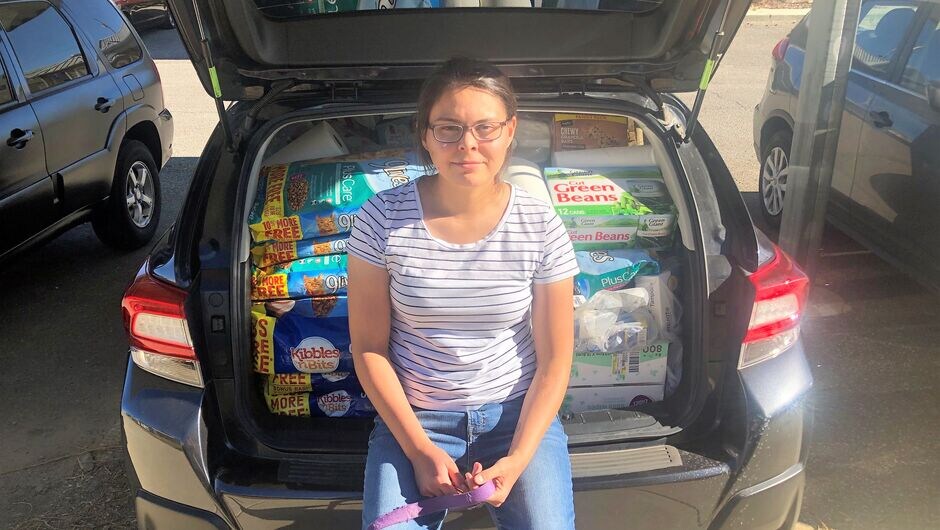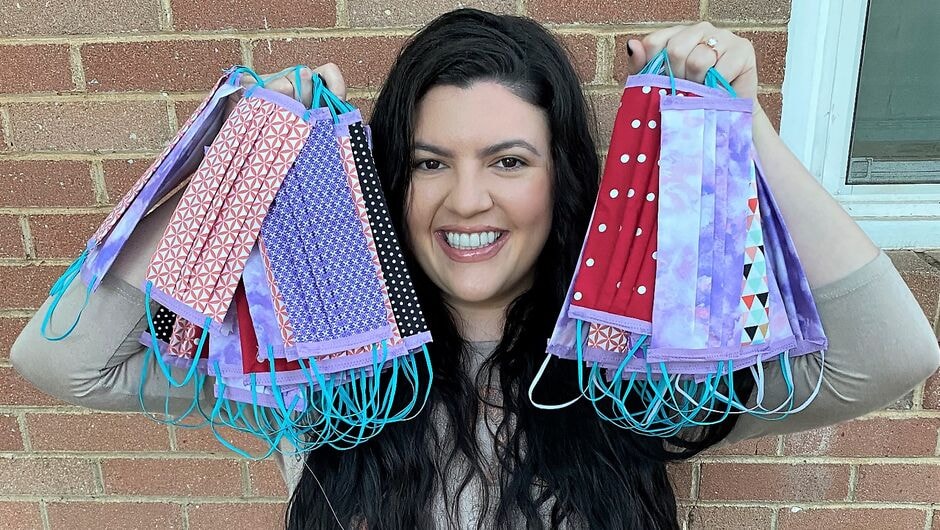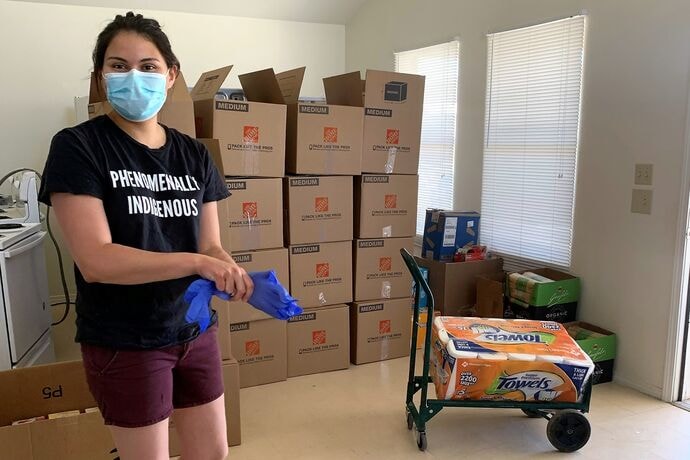Responding to the Pandemic’s Impact on Native Students
The Navajo Nation is the largest American Indian reservation in the U.S., with a population of over 200,000. The tribe’s land expands across four Southwestern states including New Mexico, making up 10 percent of the state's population. Yet this spring, more than 55 percent of the state’s COVID-19 cases were concentrated in this tribal land.
Across the country COVID-19 has had a disproportionate impact on Native communities. The reasons are complex and rooted in a long history of systemic racism and inequities in healthcare, education, and infrastructure that have only been made worse by the pandemic. In rural areas such as the Navajo Nation, many families don’t have access to basic essentials for staying safe and healthy such as electricity, running water, or internet access.
And in urban areas like Oklahoma City, in which members of 39 different tribal nations reside, many are feeling the impact of the economic downturn as local businesses close. Tribes are struggling to secure emergency federal funding to keep up with the need for personal protective equipment and to provide health services.
All of these issues have a direct impact on Native students’ wellbeing and educational opportunities. And while these challenges are very real, Native communities have responded with incredible resilience and ingenuity. They are taking collective action to protect their relatives and communities.
Challenges With Remote Learning
Kate Sultuska (Oklahoma City ‘15) is Absentee-Shawnee and teaches special education at Capitol Hill Middle School on the Southside of Oklahoma City. The city is home to more than 39 different tribal communities spread out across an urban landscape. Kate serves students from a mix of backgrounds, many of whom share multiethnic Latinx and Indigenous identities. While she is focused on special education, she is passionate about ensuring that students know their history and helped her school develop a curriculum that infuses Indigenous perspectives into every single course.
When her school closed this spring due to COVID-19, she was immediately concerned about her students, especially those who needed hands-on assistance with learning.
“The curriculum I use for my self contained classroom is majority computer-based. So I was still able to have lessons tailored to each specific child's ability level for them to access on the computer at home. But then there's the question of whether they have a computer or internet at home,” Kate says.
At the time, the district didn't have the means to send out laptops and hotspots to students’ homes. Kate’s school was able to offer free wifi from the parking lot, but not every student was able to use it, especially those who did not have access to transportation.
“If I have kids who are being raised by their grandma and there's seven kids in the house, they can't get access to the internet, they can't go anywhere,” Kate says.
Only 30 percent of the students in Kate’s class were able to successfully use the online platform for distance learning this spring. She did what she could to support her students from afar, calling her students’ families multiple times a week, making sure that her students had access to the curriculum in some format, and talking them through lessons, whether online or in print.
“I knew it wasn't enough, but I knew it was also an emergency response. it's just hard to be part of that,” Kate says.
Kate is also the school board president for Sovereign Community School, a public charter school that opened in 2019 with a focus on serving Indigenous students from different tribal communities across Oklahoma City and surrounding towns. When that school closed because of the pandemic, the principal, Matt Wilson, packed up the school’s supply of Chromebooks and drove to students’ houses to deliver them. When there were still students who needed computers, the school team disconnected the desktop computers from the school’s media center and send them home to students.
“So many Native communities don't have the capacity to do that. They don't have the available resources,” Kate says. “It’s remarkable that our school—being brand new and having such a small student population—that we were able to serve students in that way.”
A Different Sort of Transition
At Crownpoint High School located in the Navajo Nation in New Mexico, the transition to remote learning looked very different. The school serves nearly 300 Navajo students across a rural desert community. It’s the same school that Tracie Benally (New Mexico ‘19) a member of the Navajo Nation, attended as a student, and where she now teaches English and public speaking to 10th and 11th graders.
While she was teaching in person, Tracie’s classroom served as a second home for her students. She provided students with essentials, including food, deodorant, toothbrushes, feminine hygiene products, clothing, and socks. “I had everything that they would need if they needed it,” Tracie says. “They could talk to me when they didn't feel comfortable talking to anybody else.”
On the day before her school closed for spring break, Tracie and her students suspected that things would not return to normal.
“It was a very somber feeling in the room because they knew it and I knew it,” Tracie says. “And I was like, ‘You guys, I don't know if I'm going to see you after spring break. I just need you to know that I love you guys, and I need you to take care of each other.’”
With the rural broadband gap on the Navajo Nation leaving 60 percent of its residents without internet access, many students at Crownpoint lacked the connectivity, and in some cases the electricity to power online learning at home. After an extended spring break, the school sent home paper packets for students to complete and mail back to the school in mid-May. If students submitted a packet, their grade was increased by ten percentage points. If they did not, their grade remained the same.
Tracie says during the first few weeks of her school being closed, her school advised teachers to limit contact with students unless it was related to an issue with their Individual Educational Plan (IEP). After her contract with the district ended for the school year, she was relieved when some of her students found her on Instagram through photos of her dog, and started messaging her and checking in. She learned through these exchanges that some of her students had lost family members to COVID-19. Another student passed away from non-COVID circumstances. Her school sent out information about grief counselors and Tracie also did what she could to offer support to her students remotely. She feels overwhelmed thinking about the trauma her students are processing.
“We always had an issue with not having enough mental health resources for our kids,” Tracie says. “And I think that this pandemic only exacerbated it.”
Addressing Food Insecurity
The pandemic has also exacerbated other longstanding systemic inequities within the Navajo Nation. Many communities are surrounded by food deserts, with just over a dozen grocery stories spread out over an area the size of West Virginia. Over 30 percent of the tribe lacks easy access to clean running water.
At the same time, the community is tapping into the deep resiliency and safety net that they’ve turned to before. For Tracie, this meant scaling up a food box delivery system she and her school’s social worker had set up earlier in the year, to support a family grieving over the loss of a student who passed away. Together they set up a GoFundMe page with a goal of raising $1,000, which felt ambitious at the time. Within a few months they had raised almost $35,000. Donations poured in from the surrounding community, out-of-state friends and relatives, as well as from alumni at Smith College, Tracie’s alma mater.
Tracie also partnered with a local relief organization, McKinley Mutual Aid, which helped scale up their deliveries and provide food, water, and supplies to families in remote areas. When she wasn’t fundraising, Tracie was continuously available to make deliveries using her own car.
“I delivered around 50 boxes out of my tiny hatchback going to different people's houses—which doesn't sound like a lot. But it's actually a ton of work because the houses were usually 50 miles apart and only three boxes fit in my car,” Tracie says.

In Oklahoma City, Kate says that food insecurity is also a big concern for many families at Sovereign Community School, where she saw her community also spring into action. The school connected with the Auntie Project, a local organization led by multigenerational Indigenous women who serve children in need across the community. The Auntie Project coordinated with a local food bank to deliver food boxes to families and teachers from the school.
“A lot of Native families aren't apt to admit food insecurity because they think, well, I'm struggling, but someone's probably struggling more,” Kate says. “That's just the community mindset. So we made sure that we provided [food boxes] for everyone so that if someone was trying to put the community before themselves, we still have resources for them.”
Protecting Indigenous Families’ Health
The initial spread of COVID-19 in Oklahoma happened slowly, but so did the response from state officials on public safety guidance. Businesses across the city have largely remained open, and masks were only recently required by the state governor. While many tribes in the state have less control over protecting their communities, some, including the Choctaw Nation, are taking the lead by providing public health education, virtual medical visits through its tribal health centers, and pop-up clinics in remote areas of the state.
Many tribal healthcare systems in Oklahoma did not receive COVID-19 relief funds until much later than other health care facilities, which meant they had a shortage of masks and other personal protective equipment.
“A lot of people don't realize that our treaty rights include a right to health care,” Kate says. “A lot of Native people don't have health insurance. And so people expect to use their tribe's health center as their healthcare. But without PPE it’s scary. You can’t even go there.”
Kate got creative about filling this need in her community by sewing masks—hundreds of them—and donating them to tribal health centers around Oklahoma City. She’s also sent masks to Tracie to distribute to her community in the Navajo Nation.

At the beginning of the COVID-19 outbreak, the Navajo Nation was among the top three areas in the country with the highest percentage of coronavirus cases per capita. While communities are spread out, multigenerational families often live together under one roof, which makes social distancing a challenge.
As part of Tracie’s efforts to deliver food and supplies to her community in Crownpoint, she also partnered with Community Health Representatives (CHRs) from the Navajo Department of Health to provide families with health and safety resources. They contributed masks, gloves, and cleaning supplies, as well as food and hygiene supplies for babies and the elderly. CHRs also helped with deliveries, reaching the more remote communities on the reservation.
While every life lost to the pandemic is a tragedy, the risk of losing elders carries an additional weight for Indigenous communities across the country. Some elders, like Kate’s grandparents, endured a painful history, where they attended boarding school and were required to learn English, and assimilate. As a result, there are fewer elders among her grandparents' generation who were able to preserve their Native language and culture. Kate says protecting those who can pass on this vital knowledge to the next generation is critical.
“When you consider the fact that elders who do have traditional knowledge and language are dying from COVID, we're losing so much more than lives,” Kate says. “We're losing knowledge, we're losing lifeways, we're losing ceremonies.”

An Uncertain School Year Ahead
As Kate heads back to the classroom this fall, classes will begin online. She says teachers are doing their best to learn as they go. Her school is working to prepare teachers for the year and get them up to speed on new technology. But there are still a lot of unknowns. Because she teaches special education in a small group setting with 10 students, there’s a chance that her class may be among the first to return to the building. But Kate has mixed feelings.
“We're like the perfect model for starting in person, but it still scares me,” Kate says. “I feel like [my students] would be Guinea pigs, in my opinion. I'm so conflicted about it.”
Tracie returned to her classroom in Crownpoint in late August where she's teaching remote classes for at least a few weeks. The state’s Public Education Department is currently offering guidance on how to safely reopen school this fall. There are still a lot of details to figure out, such as distributing laptops to students and figuring out how to support those without wifi or electricity at home.
The big question Tracie is turning over in her mind is how she can provide her students with an excellent education while also addressing the trauma they are experiencing as a result of the pandemic. She also worries about the sustainability of everyone’s efforts, and the risk of burnout.
“I don't know the answer,” Tracie says. “But I know that nothing is done individually. Everything has been a collective effort from crowdfunding to having people come together to make sure that families are fed.”
For her part, she is focused on making her classroom a safe place to support her students through the challenges the pandemic has exacerbated, whether she’s teaching virtually or in-person. Her classroom is a place where she instills “K'é” with her students, a Navajo word for kinship and community.
“That's something that is extremely important to my identity,” Tracie says. “Not only as a community member, but as a teacher. And I try to incorporate the practice in the classroom. I refer to my classroom as the bubble where my students can unload. They can be mad, they can be angry, but they know that they're still loved, and expected to work hard.”
“When you consider the fact that elders who do have traditional knowledge and language are dying from COVID, we're losing so much more than lives.”
Outside of the classroom, that sense of kinship and social responsibility can be seen among tribes who are leading efforts to protect their communities and relatives. The Navajo Nation Tribal Council recently approved a $650 million COVID-19 relief bill that will allocate $68 million in CARES Act funding to increase broadband access as well as funds to improve access to water and electricity and expand healthcare.
And in Oklahoma City, tribes are working together to encourage Native families to complete the U.S. Census, as Indigenous populations have been historically undercounted and misrepresented in national data. This has big implications for the amount of funding for schools, healthcare, and ongoing COVID aid that tribes may be eligible to receive. “Our community needs to be seen,” Kate says. “It needs to not be overlooked in terms of relief, funding, or data.”
The pandemic has laid bare so many long standing equity issues within Native communities and Tracie knows the road ahead will be difficult. She also sees how the pandemic has shined a light on the enduring strength and resolve within the community to support and protect one another.
“I'm extremely proud to come from where I come from,” Tracie says. “We are tough and resilient people and we make things work. I'm really proud of the families who are persevering at a time that is so unprecedented.”
Tracie Benally and Kate Sultuska serve on Teach For America’s Native Alliance Advisory Council. Advisory members help guide TFA’s work to develop leaders who are committed to preserving Native culture and expanding opportunities for Native youth across the country.
We want your feedback. Share your thoughts on this story or suggest other stories for us to pursue.


